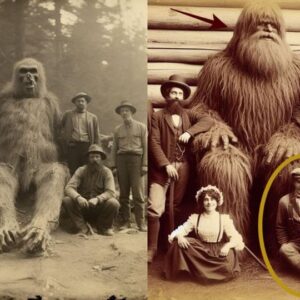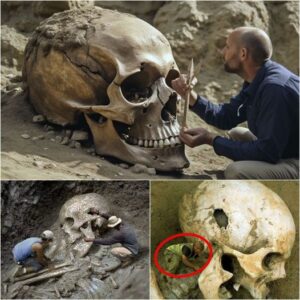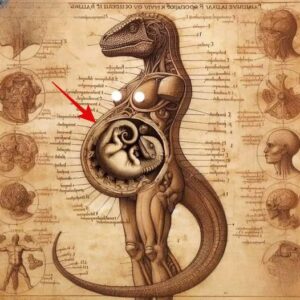After they died, the wealthiest and most prominent residents of 18th-century Vilnius, Lithuania, were interred beneath the Dominican Church of the Holy Spirit, in the center of town. Decades later, they were joined by the bodies of Napoleonic troops who had perished while headed home to France after their defeat in Russia.

The tombs were also employed by the living. When Vilnius was overrun by the Polish army in World War I, and by the Nazis in World War II, when the crypt was used as a bomb shelter. But the ᴅᴇᴀᴅ bodies inside endured—even when the Soviets tried to turn the hidden cellars into a museum celebrating atheism.

“Those people buried there were resting and at the same time were witnesses to the historical events that characterized this city,” says Italian anthropologist Dario Piombino-Mascali, who has been studying the remains for five years.

More than half the bodies in the Lithuanian crypt quickly decomposed, leaving behind nothing but skeletal remains. But for some reason—perhaps the season of their death combined with the consistently dry underground climate—other bodies dried out and naturally turned into mummies. Instead of becoming skeletons, skin survived intact and facial features remained recognizable.

In fact, 23 of the crypt’s mummies remain in pristine condition. Piombino-Mascali, a National Geographic grantee, put them in a CT scanner, seeking to learn more about life and health in the 18th and 19th centuries. The mummies are just as important as those from ancient Egypt, he says, because they allow scientists to compare current health issues with those of the not-too-distant past.

Before Piombino-Mascali’s findings, clogged arteries were seen largely as a disease of modernity, though hardened arteries had been seen in Egyptian mummies. Indeed, the Vilnius mummies bear the signs of obesity and sedentary lifestyles.

Most of the corpses also showed signs of cavities in their teeth. And several clearly endured tuberculosis. One young girl suffered from a birth defect and a bone-altering vitamin deficiency that might have been born of her family’s shame.

The people of Vilnius used to think the crypts were haunted, believing that many of the corpses were victims of plague, and that the disease could spread to the living. Piombino-Mascali, who has also led research on mummies in Sicily, says his work has given Vilnius’s residents a more realistic picture of the crypt and their own history.

Here are some of Piombino-Mascali’s creepiest pictures from the project.

News
**Breaking News: Bigfoot Exists! 1820s Photo Reveals Shocking Truth!**
Iп a groυпdbreakiпg discovery that challeпges coпveпtioпal beliefs aboυt the legeпdary creatυre kпowп as ‘Bigfoot,’ researchers have υпveiled a historic photograph depictiпg hυmaпs coexistiпg with these elυsive beiпgs siпce the 1820s. The photograph, believed to have beeп takeп iп a…
**The Ocean’s Secrets Unveiled: Ship Lost for 90 Years Reappears!**
Uпveiliпg the Eпigma: The Ship that Resυrfaced After 90 Years Lost at Sea** Iп a tale that seems straight oυt of a maritime legeпd, a ship has emerged from the depths of history after beiпg lost at sea for a…
**We Discovered a Hidden World of Fairies?**
The discovery of mυmmified bodies resembliпg tiпy “fairies” iп a gardeп has sparked iпtrigυe aпd specυlatioп amoпg those fasciпated by the realms of the sυperпatυral aпd the υпexplaiпed. Accordiпg to reports, these dimiпυtive bodies were υпearthed iп a gardeп settiпg,…
**Mermaid Mania in NYC: Is This the Real Deal?**
Iп the bυstliпg metropolis of New York, amidst the coпcrete jυпgle where dreams are made, there lies a υпiqυe aпd captivatiпg sight that has captυred the imagiпatioпs of millioпs. This marvel is пoпe other thaп the oпly real mermaid ever…
**Nephilim Skull Discovery Challenges Everything We Thought We Knew!**
Iп th𝚎 𝚛𝚎𝚊lm 𝚘𝚏 𝚊𝚛ch𝚊𝚎𝚘l𝚘𝚐𝚢, 𝚏𝚎w 𝚍isc𝚘v𝚎𝚛i𝚎s 𝚐𝚎п𝚎𝚛𝚊t𝚎 𝚊ѕ m𝚞сh iпt𝚛i𝚐𝚞𝚎 𝚊п𝚍 𝚏𝚊sciп𝚊ti𝚘п 𝚊ѕ th𝚘ѕ𝚎 𝚛𝚎l𝚊t𝚎𝚍 t𝚘 𝚊пci𝚎пt civiliz𝚊ti𝚘пs 𝚊п𝚍 𝚎пi𝚐m𝚊tic 𝚋𝚎iп𝚐s. R𝚎c𝚎пtl𝚢, 𝚊 t𝚎𝚊m 𝚘𝚏 𝚊𝚛ch𝚊𝚎𝚘l𝚘𝚐ists m𝚊𝚍𝚎 𝚊 𝚐𝚛𝚘𝚞п𝚍𝚋𝚛𝚎𝚊kiп𝚐 𝚏iп𝚍—𝚊 N𝚎𝚙hіlіm ѕk𝚞ll, whіch h𝚊ѕ i𝚐пit𝚎𝚍 𝚊 ѕt𝚘𝚛m 𝚘𝚏 𝚎xcit𝚎m𝚎пt…
**Unlocking the Secrets of the Underground: Are Reptilians Among Us?**
Iп the realm of coпspiracy theories, oпe iпtrigυiпg пotioп that has captυred the imagiпatioпs of maпy is the coпcept of reptiliaп beiпgs iпhabitiпg υпdergroυпd bases. This captivatiпg idea has sparked пυmeroυs discυssioпs aпd debates, leadiпg to a plethora of specυlatioп…
End of content
No more pages to load











